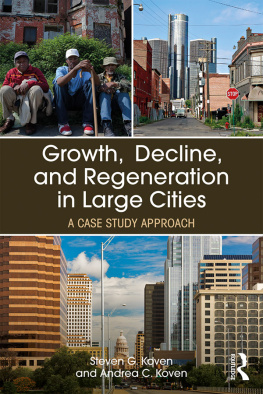Contents
Guide
Pagebreaks of the print version

Unlocking the Potential of Post-Industrial Cities
UNLOCKING THE POTENTIAL OF POST-INDUSTRIAL CITIES
Matthew E. Kahn and Mac McComas

JOHNS HOPKINS UNIVERSITY PRESSBALTIMORE
2021 Johns Hopkins University Press
All rights reserved. Published 2021
Printed in the United States of America on acid-free paper
987654321
Johns Hopkins University Press
2715 North Charles Street
Baltimore, Maryland 21218-4363
www.press.jhu.edu
Library of Congress Cataloging-in-Publication Data
Names: Kahn, Matthew E., 1966 author. | McComas, Mac, 1988 author.
Title: Unlocking the potential of post-industrial cities / Matthew E. Kahn and Mac McComas.
Description: Baltimore : Johns Hopkins University Press, 2021. | Includes bibliographical references and index.
Identifiers: LCCN 2020036272 | ISBN 9781421440828 (paperback) | ISBN 9781421440835 (ebook)
Subjects: LCSH: Urban renewalUnited StatesCase studies. | City planningUnited StatesCase studies. | Community development, UrbanUnited StatesEconomic aspectsCase studies. | Community development, UrbanUnited StatesSocial aspectsCase studies. | Labor supplyUnited StatesCase studies.
Classification: LCC HT175 .K34 2021 | DDC 307.3/4160973dc23
LC record available at https://lccn.loc.gov/2020036272
A catalog record for this book is available from the British Library.
Special discounts are available for bulk purchases of this book. For more information, please contact Special Sales at specialsales@jh.edu.
Johns Hopkins University Press uses environmentally friendly book materials, including recycled text paper that is composed of at least 30 percent post-consumer waste, whenever possible.
Contents
Preface
Over centuries, Americas older center cities have experienced growth in population and prosperity, but in recent decades, some of them have experienced decline. At any point in time, a citys history influences the look and feel of the citys built environment of houses, businesses, green spaces, and other physical infrastructure. Memories of this history affect personal interactions between groups. While history matters, expectations about the future of the place are crucial in influencing events of the present.
This book studies this interplay between history and expectations in determining the quality of life and economic growth dynamics of six major US cities. Although we approach this topic from the perspective of microeconomics, our study is informed by interdisciplinary interactions with our colleagues.
At Johns Hopkins University, the 21st Century Cities Initiative is a cross-campus urban research center that brings together faculty and researchers from the Krieger School of Arts & Sciences, the Bloomberg School of Public Health, the Whiting School of Engineering, the Carey School of Business, the School of Medicine, the School of Education, the School of Advanced International Studies, and the School of Nursing. What unites us is our common interest in how to translate research ideas into improving urban quality of life.
We must acknowledge some people whose insights have greatly improved this book. These include two anonymous reviewers, Matthew McAdam, Robert Brown, Steve Olson, Carol Kahn, Nancy McDonald, Beth Blauer, Vrshank Ravi, Kylie Patterson, Ben Seigel, Michael Braverman, Mary Miller, Andrew Cherlin, Deborah Gross, Lindsay Thompson, Stefanie DeLuca, Robert Lieberman, Jeff Lin, Randy Walsh, Marc Votruba, Pete Saunders, Phil Leaf, Steve Tobocman, Robert Embry, and Nolan Jones.
Unlocking the Potential of Post-Industrial Cities
Cities at a Crossroads
Cities can be exciting and dynamic places. When people, goods, and ideas move within a small geographic area, transportation is less costly, and learning and trade are facilitated. Well-paid people living close together can create enough demand to support cultural and religious institutions, a variety of shops and restaurants, and professional sports teams. When the local economy is flourishing, tax revenues are high enough that local governments can implement policies to improve the quality of life and help their residents escape poverty.
Cities also have their downsides. In the early 20th century, US cities suffered from infectious disease outbreaks associated with dirty water. In 2020, the spread of the coronavirus across US cities highlighted one of the demons of density. Even during normal times, living and working at high density imposes costs. People in cities are more likely to be exposed to crime, pollution, and traffic. This book focuses on the challenges for the center city of a metropolitan area. We define a center city as the central urban political jurisdiction in a metropolitan area, such as that of the City of Philadelphia. Most center cities, viewed apart from their surrounding suburbs, have pockets of concentrated poverty where many people live in conditions that make it difficult for them to achieve their goals and for their children to achieve their full potential.
Over time, some cities become stronger while others grow weaker. Between 1970 and 2018, the population of the City of Las Vegas grew from 126,000 to 644,000; during those same years, Baltimore Citys population shrank from 906,000 to 603,000. Cities also differ with respect to their populations skill level and poverty rate. In 2010, relative to the national urban average, Baltimore residents were less likely to be college graduates and more likely to be living in poverty.
This book explores why six center cities stretching from the mid-Atlantic states to the central MidwestBaltimore, Cleveland, Detroit, Philadelphia, Pittsburgh, and St. Louishave lost population and seen their poverty rates rise over the past 50 years. More than 3.8 million people live in these cities. More than a quarter of their residents are poor, and more than half are African American. Why arent more people in these cities enjoying the American Dream of upward mobility? Why havent more companies moved to these cities or started up in them? Why have politicians, business interests, and community leaders been unsuccessful in rebuilding these cities after major industries left?
Our six cities are not homogenous; some have enjoyed greater success in fostering economic development, reducing violent crime, educating the next generation, and ameliorating poverty. Philadelphia and Pittsburgh, among our set of six, have experienced the most progress, as synergies between their universities and medical centers have caused growth in high-tech jobs. Our six cities may not be the same, but they do have similar histories and a common set of challenges that we highlight throughout the book. They also offer case studies of places where people struggle to achieve the American Dream. The lessons learned from them can be applied to struggling neighborhoods in cities across America with high levels of violent crime, stagnant job growth, low educational attainment, and environmental challenges.
Our six cities are often portrayed as dangerous, dirty, poor, and corrupt shells of their former industrial glory. This coarse description simultaneously borders on caricature and contains elements of truth. What is the urban experience for the millions of people who call these cities home? What differences exist among the neighborhoods that compose these cities? Millions of people watched HBOs show














